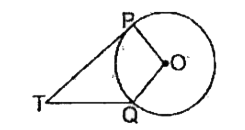P and Q are two points on circle with centre O. The point R is on the minor arcPQ. The tangents from P and Q meet at S. If ∠PSQ=20∘ them ∠PRQ is-
80∘
200∘
100∘
160∘
To solve the problem, we need to find the measure of angle PRQ given that angle PSQ is 20 degrees. We will use properties of circles, tangents, and cyclic quadrilaterals to arrive at the solution.
1. Identify the Given Information:
- Points P and Q are on the circle with center O.
- R is on the minor arc PQ.
- The tangents from points P and Q meet at point S.
- Angle PSQ = 20 degrees.
2. Draw the Diagram:
- Draw a circle with center O.
- Mark points P and Q on the circumference.
- Draw the tangents from P and Q meeting at point S.
- Mark point R on the minor arc PQ.
3. Use the Tangent-Radius Theorem:
- The radius OP is perpendicular to the tangent PS at point P, so angle OPS = 90 degrees.
- Similarly, the radius OQ is perpendicular to the tangent QS at point Q, so angle OQS = 90 degrees.
4. Calculate Angle POQ:
- Since angles OPS and OQS are both 90 degrees, the angles around point S must sum to 180 degrees:
Angle POQ+Angle PSQ=180∘
- Substituting the known value:
Angle POQ+20∘=180∘
- Therefore, angle POQ = 180 - 20 = 160 degrees.
5. Relate Angle POQ to Angle PAQ:
- The angle at the center (POQ) is twice the angle at the circumference (PAQ):
Angle PAQ=12×Angle POQ=12×160∘=80∘.
6. Use the Cyclic Quadrilateral Property:
- Since points P, A, R, and Q form a cyclic quadrilateral, the sum of the opposite angles is 180 degrees:
Angle PAQ+Angle PRQ=180∘.
- Substituting the known value of angle PAQ:
80∘+Angle PRQ=180∘.
- Solving for angle PRQ:
Angle PRQ=180∘−80∘=100∘.
Final Answer:
Angle PRQ = 100 degrees.
- Points P and Q are on the circle with center O.
- R is on the minor arc PQ.
- The tangents from points P and Q meet at point S.
- Angle PSQ = 20 degrees.
- Draw a circle with center O.
- Mark points P and Q on the circumference.
- Draw the tangents from P and Q meeting at point S.
- Mark point R on the minor arc PQ.
- The radius OP is perpendicular to the tangent PS at point P, so angle OPS = 90 degrees.
- Similarly, the radius OQ is perpendicular to the tangent QS at point Q, so angle OQS = 90 degrees.
- Since angles OPS and OQS are both 90 degrees, the angles around point S must sum to 180 degrees:
Angle POQ+Angle PSQ=180∘
- Substituting the known value:
Angle POQ+20∘=180∘
- Therefore, angle POQ = 180 - 20 = 160 degrees.
- The angle at the center (POQ) is twice the angle at the circumference (PAQ):
Angle PAQ=12×Angle POQ=12×160∘=80∘.
- Since points P, A, R, and Q form a cyclic quadrilateral, the sum of the opposite angles is 180 degrees:
Angle PAQ+Angle PRQ=180∘.
- Substituting the known value of angle PAQ:
80∘+Angle PRQ=180∘.
- Solving for angle PRQ:
Angle PRQ=180∘−80∘=100∘.
Angle PRQ = 100 degrees.
Topper's Solved these Questions
Similar Questions
Two tangents are drawn from a point P on the circle at point A and B. O is the centre of the circle. If ∠AOP=60∘ then find ∠APB.
View SolutionPA and PB are two tangents to a circle with centre O, from a point P outside the circle. A and B are points on the circle. If ∠APB=100∘ , then OAB is equal to:
View Solution
Knowledge Check
P and Q are two points on circle with centre O. The point R is on the minor arcPQ. The tangents from P and Q meet at S. If ∠PSQ=20∘ them ∠PRQ is-
A80∘B200∘C160∘D100∘P and Q are two points on circle with centre O. The point R is on the minor arcPQ. The tangents from P and Q meet at S. If ∠PSQ=20∘ them ∠PRQ is-
A200∘B160∘C100∘D80∘Let P and Q be two points on a circle with centre O. If two tan gents of the circle through P and O meet at A with ∠PAQ=48∘, then ∠APQ is
A96∘B48∘C66∘D60∘
(A) Choose the correct alternative :
O is a centre of a circle, Tangents TP and TQ of the circles itersect at point T in the exterior of the circle. Points P and Q lie on the circle . If ∠POQ=120∘ then ∠PTQ=?
View SolutionTwo tangents drawn at the points A and B of a circle centred at O meet at P. If ∠AOB=120∘ then ∠APB:∠APO is
View SolutionAB is the diameter of a circle with centre O. The tangent at a point C on the circle meets AB produced at Q. If ∠CAB=42∘, then what is the measure of ∠CQA?
AB एक वृत्त का व्यास है जिसका केंद्र O है | वत्त पर स्थित एक बिंदु C से गुजरने वाली स्पर्श रेखा AB से Q पर मिलती है | यदि ∠CAB=42∘ है, तो ∠CQA का मान क्या होगा ?
View SolutionTP and TQ are tangents from T to the circle with centre O. Then is it possible to draw a circle through the points P, O, Q and T ?

View SolutionPA and PB are two tangents to a circle with centre O, from a point P outside the circle. A and B are points on the circle. If ∠APB=40∘, then ∠OABis equal to:
View Solution
